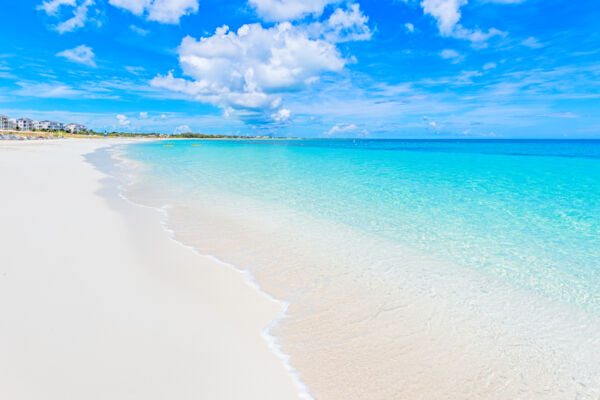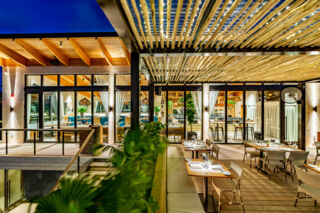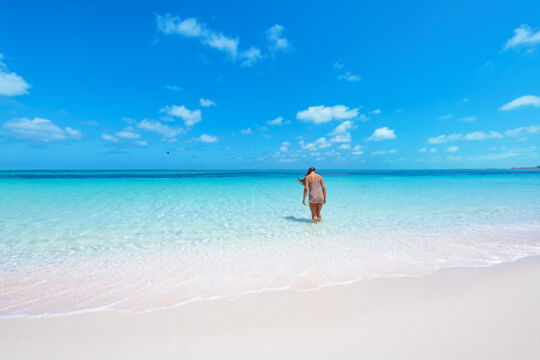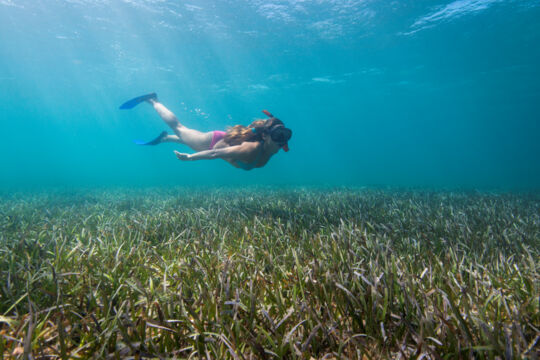The Bight Beach Providenciales

The beautiful Bight Beach is found on the central north coast of Providenciales, west of and adjacent to world-famous Grace Bay Beach. This coast is typically sheltered from the common eastern trade winds. Hence, the water here is usually calm and clear.
Unlike Grace Bay Beach, the Bight Beach has lush seagrass that grows on the ocean floor starting approximately 75 feet (23 m) off the beach. The seagrass beds are home to interesting ocean life, including stingrays, eagle rays, starfish, hawksbill turtles, and nurse sharks.
As is a common trait with beaches in the Turks and Caicos, the sand at the Bight Beach is clean and a brilliant white. The central stretch of the coast is also a bit wider than many other beaches on the island, due to accretion (the gradual buildup of sand) over the years.
On its eastern end, the Bight Beach begins where Grace Bay Beach ends at The Bight Reef (Coral Gardens) and continues west 1.5 miles (2.3 km) to Smith’s Reef in the Turtle Cove area.
Many of the villas and hotels on the Bight Beach claim to be on Grace Bay. While the Bight Beach is excellent, it is its own distinct section of the coast. For more information, read Beaches of Providenciales.
Snorkeling

Several small reefs are found in the area, the most famous of which is The Bight Reef (Coral Gardens).
A small collection of coral heads can also be found about 750 feet (225 m) out from Wymara Resort, along with a beautiful little reef located 330 feet (100 m) out and 900 feet (274 m) west of the main Bight Park (Children's Park) access.
Due to the seagrass and reef marine environment, hawksbill turtles, green turtles, southern stingrays, eagle rays, and barracuda are more common at the Bight Beach than at Grace Bay.
Although not part of the Bight Beach, the nearby Smith’s Reef boasts excellent snorkeling.
Dangers
By far the greatest danger to swimmers is the reckless usage of powerboats, which blatantly ignore the law without repercussion. Over the years, at least two people have been killed by being struck by a boat. Most of the reckless driving is by small vessels offering banana boat and wake rides. Changes in the law require that such boats have a dedicated spotter, however this law is not enforced and is often not followed. It’s important to be aware of these boats.
The Bight Beach is part of the Princess Alexandra National Park, which has a 15 mph (24 km/h) speed limit for power vessels. Most boat operators flagrantly ignore this rule.
The coast typically does not have any major currents. When kayaking, paddleboarding, or swimming far out, be aware that the wind is usually blowing offshore and it may be difficult to return to the beach.
Accommodation and Dining



Bight Beach Accesses
The Bight Beach has one main beach park and several small lane beach accesses. For most, the primary Bight Park beach access is the best choice with ample parking space. However, this access has irregular opening hours. For those seeking more seclusion, the other accesses are a good choice.
Note that the restrooms at the Bight Park beach access are not functional.
Other accesses can be found at the Bight Reef snorkeling site, and off Sellar's Cut, Lizard Lane, and Delancy Lane.



